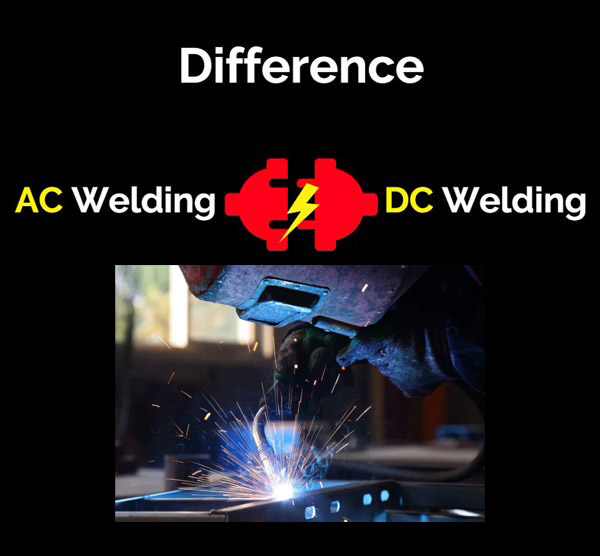AC Welding vs DC Welding:Differences, Pros & Cons
Often confusing for beginners and professionals alike is the topic of AC vs DC welding. AC and DC refer to the power supply used for the process of welding, and they do have their significant differences.
To clarify some doubt, we are going to dive deeper into what the differences are between AC and DC welding, the advantages each possesses, and which of the two currents do the common welding methods utilize.
What Is the Difference Between AC and DC Welding?
The main difference between AC welding and DC welding is the alternating polarity. Direct Current or DC welding provides a stable arc and results in quality welds on most metals. AC welding works best for aluminum and is suitable for magnetic parts since AC eliminates arc blows.
To understand the difference between the two currents, let’s examine what AC and DC welding is exactly.
AC Welding
The term AC (Alternating Current) refers to the direction in which the electrons flow (electricity) when supplying power to your welding machine. With an AC current, the electrons change directions forward and backward. These electrons always travel at a steady pace and change direction between forward and backwards 50 percent of the time. As AC welding electrons flow irregularly, this also produces irregular welding polarity (the electric circuit flows through both positive and negative poles).
DC Welding
Also known as Direct Current, the term DC once again refers to the direction in which electrons flow. When utilizing DC welding the electrical electrons will always flow in a single direction at a steady pace, which is classed as forward. Because a DC current flows just in a singular direction, the polarity the welder will experience is very constant.
DC or AC Welding? Strength and Uses
So there is an obvious electrical difference between AC and DC currents with flow rate and polarity consistencies, but how does this affect one’s welding?
When using an AC Welder for welding one can expect to experience inconsistent heat input and uneven weld appearance. This is connected to the alternating flow of electrons which makes the weld heat input irregular. As the heat input is constantly changing the final weld appearance also can be viewed as uneven (an even weld appearance would need consistent heat input).
Despite these negatives, the irregular current in AC welding is excellent to use upon parts that are magnetic (as AC provides a more steady weld arc). The inconsistent electron flow eliminated arc blows and produces a much more fluid weld upon these materials than DC welding could.
AC welding is an excellent option for aluminum parts. Notable with aluminum is how the AC currents flow “scrubs” the surface of the aluminum removing oxides that would impact weld quality, without an AC current, welding aluminum would be challenging.
When we use a DC current the effect is very different from that of an AC welder. DC welding produces a steady, single directional, electron current and it is the most commonly used type of welding current. DC is quite the opposite to irregular AC current, the consistent DC current produces a stable weld arc and allows for excellent control of heat input.
Overall improved weld quality and aesthetics are the results and this explains why it is desirable to use more regularly throughout industries.
Pros and Cons of AC vs DC Welding
| AC Welding PROS | DC Welding PROS |
| Great for Aluminum welding | Quality and heat control are superior |
| Functions well upon magnetic workpiece | Best option for most welding positions and methods |
| Best current to transmit electricity over long distances | More flexible to use upon a variety of materials |
| Downhand and penetrative welding is more efficient | Efficient for welding thin materials |
| Cheaper process overall | Produces more reliable welds |
| AC Welding CONS | DC Welding CONS |
| Limited with its application | Equipment can be expensive |
| More splatter produced | Less penetration in welds |
| Unreliable and more difficult to operate | Not suitable for specific metals |
When to Use AC or DC for Welding?
Stick Welding
Typically, when stick welding we would use the DC current to weld most materials of any thickness or shape. This is with the exception of magnetic materials, in this situation, we would use the AC current to prevent Arc Blow (where the magnetic field forces the molten metal away from the weld pool).
The shipbuilding industry also commonly uses AC stick welders to prevent unwanted arc blow and allow for deep weld penetration.
MIG Welding AC or DC?
95% of MIG welders will use the DC setting for its stability and quality of performance. A DC MIG welding machine is better due to reliable arc which results in steady heat and weld quality.
We do occasionally see very cheap, low-quality gasless MIG welders that function on the AC setting but it is not recommended to weld with such a machine for quality reasons.
TIG Welding AC or DC?
TIG welding is the method of welding that makes use of both AC and DC settings most regularly. If welding aluminum the most likely choice of current would be the AC current while all other materials, such as stainless or mild steel, would require a DC current.
Final Notes
It is clear that when choosing to use AC vs DC that the decision depends on many variables. By understanding these variables and what is required of each individual welding process selecting between AC and DC currents can be easy. Practice always makes one’s skill set more refined.


